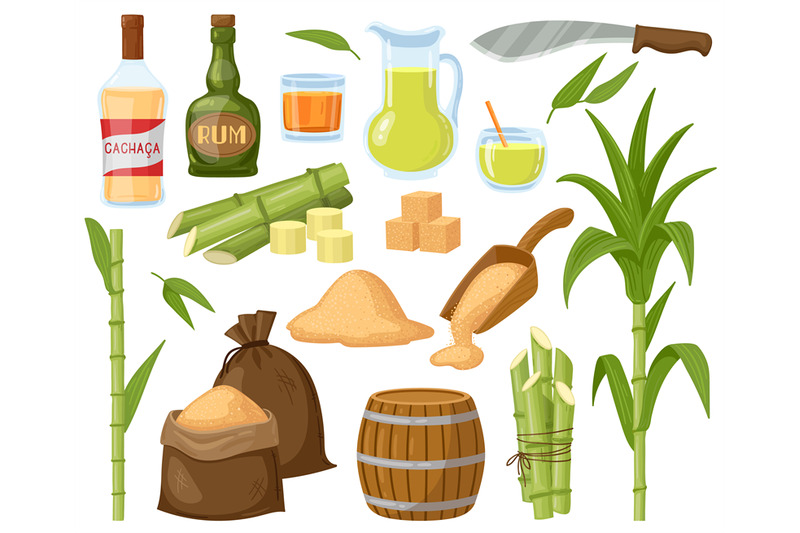Eco-Friendly Fuels Made from sugar cane products: A Sustainable Shift
A Deep Dive Into Sugar Cane: Insights on Production, Supplies, and Product Growth
Sugar cane plays a vital duty in farming, underpinning economic climates in exotic areas. Its farming includes intricate processes influenced by numerous environmental aspects. Cultivators encounter significant obstacles, consisting of climate change and market variations. Technologies in item development are emerging in reaction to evolving consumer needs. Comprehending these dynamics is crucial for grasping the future of this important plant and its effect on worldwide markets. What lies ahead for sugar cane and its myriad applications?
The Value of Sugar Cane in Global Agriculture
Sugar cane serves as an important plant in worldwide agriculture, underpinning economic situations and food systems in lots of tropical regions. This flexible plant is mostly grown for its high sucrose web content, which is refined into sugar, a standard ingredient in countless food products. Past sweetening, sugar cane is additionally crucial for generating biofuels, specifically ethanol, adding to energy sustainability.The economic significance of sugar cane reaches work, giving resources for numerous farmers and workers in processing facilities. In a number of nations, sugar cane cultivation and handling stand for considerable sections of farming GDP, affecting profession equilibriums and regional development.Additionally, sugar cane's versatility to different climates boosts its value as a crop, ensuring constant supply in global markets. Its by-products, consisting of molasses and bagasse, additionally expand its energy, making it a crucial element in food, power, and sector. Overall, sugar cane stays a cornerstone of agricultural performance worldwide.
Cultivation Procedures: From Growing to Harvest
Cultivating sugar cane involves a collection of distinct procedures that guarantee suitable growth and yield. The cultivation begins with land preparation, where the soil is tilled to protect ideal oygenation and drain. Following this, seed cane, which contains fully grown stalks, is selected and reduced into sections (sugar cane products). These sectors are then planted in furrows, making certain appropriate spacing to permit sunlight and nutrient access.Once grown, watering systems are used to keep adequate moisture degrees, as sugar cane grows in moist conditions. Weeding and insect administration are essential throughout the expanding period to lessen competition for resources. Nutrient application, including plant foods, sustains durable growth. As the plants develop, monitoring for illness and bugs continues.Harvesting typically occurs 10 to 24 months post-planting, depending on the variety. The walking canes are reduced close to the ground, guaranteeing very little waste, and are quickly moved for refining to protect sugar high quality
Geographic Distribution of Sugar Cane Production
The geographic distribution of sugar cane production is mostly formed by particular climate and dirt needs. Major creating nations, such as Brazil, India, and China, gain from exotic and subtropical environments that sustain the plant's development. Understanding these elements supplies insight into the worldwide landscape of sugar cane growing.
Major Producing Countries
Although sugar cane is expanded in different regions worldwide, specific countries dominate production due to favorable climates and farming practices. Brazil leads the international market, making up about one-third of overall production, thanks to its substantial vineyards and advanced cultivation strategies. India adheres to as a significant producer, gaining from both positive climate condition and a large residential market. China and Thailand additionally place among the leading manufacturers, with well-established infrastructures supporting their sugar markets. Various other remarkable factors consist of the United States, Mexico, and Australia, each leveraging their unique agricultural systems to enhance result. These countries play a vital role in the sugar cane supply chain, influencing worldwide rates and accessibility
Environment and Dirt Requirements
Suitable environment and dirt conditions are crucial for effective sugar cane production. Sugar cane flourishes in exotic and subtropical areas, needing warm temperature levels between 20 ° C and 30 ° C (68 ° F to 86 ° F) These plants require abundant sunshine and rains, preferably in between 1,500 to 2,500 millimeters annually, to assure peak growth. The soil should be well-drained, abundant, and abundant in natural issue, with a pH degree ideally between 5.5 and 8.5. Sandy loam or clay loam soils are especially for sugar cane farming, providing necessary nutrients and drainage. Geographical circulation is mainly affected by these aspects, with significant production areas located in Brazil, India, and China, where ecological problems line up with the plant's demands for growth and yield.

Obstacles Dealt With by Sugar Cane Growers
Sugar cane growers run into considerable challenges that affect their source of incomes. Environment modification presents unforeseeable climate patterns, influencing crop return and high quality. Furthermore, market cost volatility produces financial uncertainty, complicating long-term planning for these farming manufacturers.
Climate Adjustment Impacts

How do environment change impacts impact the viability of sugar cane growing? Increasing temperatures and erratic climate patterns hop over to here notably test sugar cane farmers. Increased heat can lead to lowered returns, as the plants struggle to flourish in severe problems. Furthermore, altered rains patterns cause either dry spells or extreme flooding, both damaging to crop health and wellness. Parasites and conditions are likely to proliferate in warmer climates, better harmful production. In addition, dirt destruction and salinization due to climbing water level can decrease cultivatable land. These weather modifications urge farmers to adapt their techniques, usually calling for financial investment in brand-new modern technologies and resistant crop varieties. Eventually, the sustainability of sugar cane growing hinges on resolving these climate tests successfully.

Market Value Volatility
Market value volatility presents considerable obstacles for sugar cane farmers, impacting their financial stability and planning. Changes in market value, driven by factors such as worldwide supply and demand, weather, and government policies, produce uncertainty for manufacturers. This changability makes it difficult for growers to anticipate revenues and take care of general expenses effectively. Furthermore, when rates drop suddenly, numerous farmers might have a hard time to cover production expenses, causing prospective economic distress. To reduce these risks, some farmers transform to contracts or hedging methods, yet these services might not come to all. Market cost volatility continues to be a persistent problem, affecting the overall sustainability and success of sugar cane farming.
Comprehending the Sugar Cane Supply Chain

Market Fads Influencing Sugar Cane Rates
The dynamics of sugar cane costs are affected by a variety of market trends that mirror more comprehensive economic problems and consumer habits. Worldwide need for sugar and sugar-related products plays a necessary role, with enhancing passion in organic and sustainably sourced items driving rates higher. In addition, changes in oil rates affect the price of production and transport, additional affecting market rates. Weather patterns are one more significant factor; damaging conditions can bring about lowered returns and enhanced prices. Profession plans, tolls, and worldwide agreements additionally shape the market landscape, affecting supply chains and accessibility. Currency exchange prices can make complex global profession, impacting prices for both merchants and importers. Changes in consumer choices towards much healthier options may change need patterns, producing a ripple effect on sugar cane prices. sugar cane products. Recognizing these interconnected patterns is essential for stakeholders in the sugar sector.
Advancements in Sugar Cane Item Growth
Many developments in sugar cane item development are improving the sector and expanding its applications. Scientists are exploring alternative usages beyond traditional sugar, including biofuels, biodegradable plastics, and health and wellness great site supplements. Advances in enzymatic processing methods have improved the removal of valuable compounds such as antioxidants and vitamins from sugar cane, advertising its usage in useful foods.Additionally, the advancement of genetically modified sugar cane selections intends to boost return and resistance to insects, while additionally improving the nutritional profile of the crop. Technologies in fermentation processes have actually resulted in the production of high-grade liquors stemmed from sugar cane, appealing to an expanding market for craft spirits.Moreover, sustainable methods in cultivation and processing are getting traction, with a concentrate on minimizing environmental effects. These advancements not only create new market chances yet additionally promote an even more sustainable approach to sugar cane production, aligning with global fads in the direction of green items.
Often Asked Questions
What Are the Environmental Effects of Sugar Cane Farming?
The environmental effects of sugar cane farming consist of deforestation, loss of biodiversity, water pollution from plant foods and chemicals, dirt destruction, and greenhouse gas emissions, every one of which greatly add to ecological inequalities and environment adjustment.
How Does Sugar Cane Growing Affect Local Economies?
Sugar cane growing significantly affects neighborhood economic climates by developing tasks, stimulating agricultural fields, and creating revenue for farmers. Nonetheless, it can additionally lead to economic dependence and variations based upon market needs and environmental problems.
What Are the Key Vermin and Diseases Affecting Sugar Cane?
The primary insects affecting sugar cane include the sugarcane borer and aphids. Illness such as red rot and smut considerably impact yield. Farmers need to execute incorporated bug management methods to alleviate these risks efficiently.
How Is Sugar Cane Processed Into Different Products?
Sugar cane handling involves crushing the stalks to remove juice, followed by explanation, dissipation, and formation. This process returns raw sugar, molasses, and ethanol, each serving distinct functions in different markets, from food to power.
What Are the Nutritional Aspects of Sugar Cane?
The dietary elements of sugar cane include crucial minerals and vitamins, particularly B vitamins, calcium, and iron. It additionally consists of fiber, though mostly made up of sucrose, why not try this out which offers energy but does not have substantial nutrients.